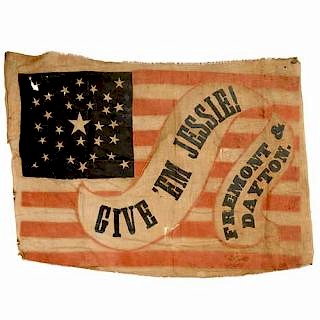Civil War Engraved Powder Horn from Fort Donelson, 1862
About Seller
6270 Este Ave.
Cincinnati , OH 45232
United States
With offices in Cincinnati, Cleveland and Denver, Cowan’s holds over 40 auctions each year, with annual sales exceeding $16M. We reach buyers around the globe, and take pride in our reputation for integrity, customer service and great results. A full-service house, Cowan’s Auctions specializes in Am...Read more
Two ways to bid:
- Leave a max absentee bid and the platform will bid on your behalf up to your maximum bid during the live auction.
- Bid live during the auction and your bids will be submitted real-time to the auctioneer.
Bid Increments
| Price | Bid Increment |
|---|---|
| $0 | $25 |
| $500 | $50 |
| $1,000 | $100 |
| $2,000 | $250 |
| $5,000 | $500 |
| $10,000 | $1,000 |
| $20,000 | $2,500 |
| $50,000 | $5,000 |
| $100,000 | $10,000 |
About Auction
Nov 18, 2016 - Nov 19, 2016
Cowan's Auctions dawnie@cowans.com
- Lot Description
Very small powder horn, possibly carved by a Union or Confederate soldier. This may be a “Tyler, Texas” example. Curved shape, 6.5 in. overall, with flat, thick wood base. The entire perimeter of the wood rim features a deeply carved series of twelve five-point stars. A profile view of an armored-type, Civil War-era steam-powered warship with single smokestack and very bold representation of smoke emitting from that stack is primitively and yet quaintly carved on the underside of the wooden base of the horn, almost filling it full length (right to the edge of the wood base). Flying at the back of that vessel is a large representation of a flag, which at first glance and with a magnifying glass, appears to be a Union flag with many stripes, but could conceivably be a crude representation of a Confederate flag.
The largest carving, located at the center of the pipe, is an open-winged flying eagle (clutching sheaf of arrows in claw) holding in its beak a large representation of an unfurled, twisted, long banner-like flag, which is apparently American, as the groups of stars can be seen and the representation of what appears to be stripes. Flying above that eagle, over its left wing, near the center of the horn, is a decidedly large representation of a carved Confederate flag. Other carvings on reverse (toward the inner curve) side of the horn include a nicely done, but decidedly primitive three-massed, square-rigged sailing vessel (a warship) flying a very crude representation of a flag, which could possibly have been to indicate either Confederate or Union; however it is not clear enough to discern. Below that warship, near the base of the horn, a small single-massed, single sail schooner. Also at bottom of horn, well below the left wing of the eagle, is a small single-massed dory row-boat with a civilian clad primitive representation of a hunter seated near the middle of the boat, shooting a flying bird or duck (not discernible), but the blast from his shotgun definitely visible/carved. Above that vessel (between it and the eagle's wing) is a reasonably large, carved, fouled anchor, and to the right of that anchor and just below the eagle's wing, a decided representation of a Maltese cross insignia of an American Army Corps. Other representations, which seem similar to those found on a "Tyler, Texas" horn, include a large, simple profile head of a horse above a floating duck; a primitive floral motif on a branch with two leaves; and beneath the right wing and eagle's claw with arrows, a small five-point star design surrounded with simple carved lines in a sunburst-like motif; very center of that star is a series of simple primitive carved parallel lines.
With FORT / DONELLSON [sic] / 1862 primitively carved near top of horn.
The Battle of Fort Donelson was fought from February 12-16, 1862. The capture of this fort by Union forces opened the Cumberland River as an avenue of invasion of the South and elevated Brigadier General U.S. Grant from an obscure and largely unproven leader to the rank of major general.
Provenance: Property of N. Flayderman & Co.Few light scratches, some surface wear to horn.Condition
- Shipping Info
-
SHIPPING. At the request of the buyer, Cowan's will authorize the shipment of purchased items. Shipments usually occur within two weeks after payment has been received. Shipment is generally made via UPS Ground service. Unless buyer gives special instructions, the shipping method shall be at the sole discretion of Cowan's Auctions, Inc.. Cowan's is in no way responsible for the acts or omissions of independent handlers, packers or shippers of purchased items or for any loss, damage or delay from the packing or shipping of any property.
-
- Buyer's Premium



 EUR
EUR CAD
CAD AUD
AUD GBP
GBP MXN
MXN HKD
HKD CNY
CNY MYR
MYR SEK
SEK SGD
SGD CHF
CHF THB
THB







![[MEDICAL HISTORY] Craig Gutta-Percha Microscope Base](https://s1.img.bidsquare.com/item/m/2904/29046456.jpeg?t=1Ttr6w)
![[CIVIL WAR] William T. Sherman CDV Portrait](https://s1.img.bidsquare.com/item/m/3259/32590994.jpeg?t=1UVtrf)
![[LINCOLN] Abraham & Mary Todd CDV Portraits](https://s1.img.bidsquare.com/item/m/3194/31943004.jpeg?t=1UDVtx)
![[THEODORE ROOSEVELT] Naval Commission, 22 May 1908](https://s1.img.bidsquare.com/item/m/3258/32582659.jpeg?t=1UUDch)
![[LINCOLN] 1860 Benjamin Grierson Composed Anti-Slavery Songsheet](https://s1.img.bidsquare.com/item/m/3150/31508307.jpeg?t=1Urgsc)
![[LINCOLN] 8th IL Cav. Vet Met Lincoln](https://s1.img.bidsquare.com/item/m/3150/31503939.jpeg?t=1UreKU)
![[CIVIL WAR] Black Soldier's Memorial Portrait, 1st Missouri Colored Infantry](https://s1.img.bidsquare.com/item/m/2985/29854261.jpeg?t=1TPbS9)
![[AFRICAN AMERICANA] Well-Dressed Black Gentleman](https://s1.img.bidsquare.com/item/m/3260/32600916.jpeg?t=1UVFyL)
